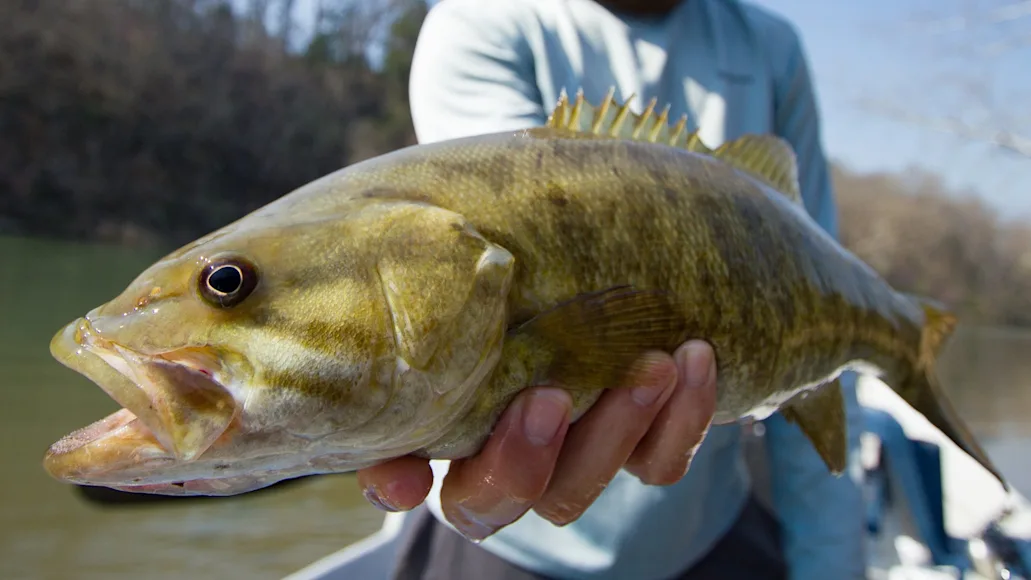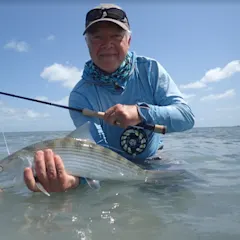THE FISH took its own sweet time, as smallmouth bass
will sometimes do, eyeballing the rubber-legged popper as it drifted along the edge of a grass bed. I followed with the rod tip. You can’t rush fishing like this. You shouldn’t rush anything, in fact, when the summer sun is blazing overhead and sweat runs down your back. So I mended the line upstream, and let the popper ride.
“Give it a twitch,” Wesley Hodges said. The outfitter and guide was behind me, on the drift boat’s oars, and I’d long since figured out that the man misses nothing on the water. He knows what my fly is doing. He knows what my buddy’s fly is doing. He knows where he needs to be to drop the boat through every ledge on this stretch of Virginia’s New River. You could make 1,000 casts, and Hodges could dissect every one.
I might have twitched. I’m not sure I had the time. But in the very next instant, the popper vanished in a ferocious, surface-shattering strike.
Ga-SCHLORP!
I heard the take as much as I saw it. And I felt it like a jolt of electricity.
“Look at that eat!” Hodges hollered. As I fed fly line through the guides to put the fish on the reel, it made a rush for the heavy current—as smallmouth bass will often do—and I turned it back to the shallows with a low sweep of the rod. Hodges netted the bass, and as he peered down its gullet to remove the fly, he cackled. Inside the smallie’s mouth, a crayfish the size of half a cigar was crammed beside the white popper. You couldn’t have rammed a mosquito between the two.
“What a pig,” I said. “He didn’t even wait to swallow that crawdad before he smashed the popper!”
Hodges cracked a wide grin. “That’s what we’re here for, buddy,” he said. “There is simply nothing better than topwater smallies in the summer.”

The author shows off a smallmouth bass caught on the surface of the New River. Courtesy of T. Edward Nickens
Raising the Stakes
It’s a sentiment that begs the question: Is there anything better than a topwater eat? I’m not sure there is. There aren’t many anglers who would rather feed a fish in the deep unseen than watch it crash a bubbling, gurgling, or floating bug—even if your lure is bobbing down the current as gently as a sweat bead dripping down your back. Whether it’s a basic popping bug, dry fly, Skitter Walk, or classic Jitterbug
, watching the exact moment when a fish goes all in is a dopamine dump straight into your brain, and one that you simply can’t get enough of.
Hodges, my buddy Mike Riddick, and I were on a serpentine stretch of broad river that runs through national forest and broad mountain valley farm fields, where the ledges that undergird the Blue Ridge have been weathered smooth and bare. In addition to poppers, we had rods loaded with traditional streamers and swim flies that could flutter through and probe every pothole in the river bottom, but we only fished the sinking stuff when it seemed like the floating stuff wasn’t working.

Lunch is served. Living the life on the New River. Courtesy of T. Edward Nickens
It’s how I grew up fishing. As a kid, I kept a grab bag of Jitterbugs and Hula Poppers handy—small and large, black and white, and a few decked out like a tasty frog. Whether targeting the walkable shoreline of a large municipal reservoir or sneaking on to a golf course pond, there were long stretches in my fishing youth when I would rather not fish at all if I couldn’t score a topwater eat. I’ve since broadened my horizons—but not all that much, to be honest. I jump at the chance to feed fish on the surface, whether that’s casting white Wulffs to Susquehanna River smallmouth as the sun goes down, chunking hoppers to cutthroats, or ripping crease flies across a school of busting Spanish mackerel
. When you like it on top, you can typically find a way to make it work.
Just last week I was casting shrimp flies into the pooling light of underwater dock lights at the coast. We didn’t even start fishing until after 11 o’clock, to give the speckled trout time to settle down and get comfortable after a full day of bright light and boat traffic. It was an almost spooky scene. The fly lines glowed in the bright lights, and the flies were backlit as we twitched them across the surface. When the trout rose to pummel the flies, we could see them coming—dark blobs rising through the eerie green light like phantasms. When they smacked the shrimp, it was with pure abandon. They were all in. There was no question about what was happening at the end of the line.
I guess that’s part of the attraction of a surface eat. There’s so much in fishing that is unseen and unknown. Am I at the right depth? Am I moving the lure too fast? Was that a nibble or a piece of grass? Was that a bump or the bottom? In a world of vanishing absolutes, there is nothing equivocal about a hungry trout, bass, or bluegill smashing a dry fly, pencil popper, or foam spider. Sure, you can strike too early or too late, and there are a few instances in which the fish simply misses the bait. But most of the time you could turn your pockets inside-out and still come up empty of excuses: You either have a fish on the line, or you had your chance, buddy.
If You Go: Where to Book a Virginia Fishing Trip
smallmouth bass fishing trips and ruffed grouse and woodcock trips across a stunning stretch of the Virginia Appalachians. His outfitter camp includes glamping cottages and a gorgeous restored farmhouse.
_Read more F&S+
stories._






